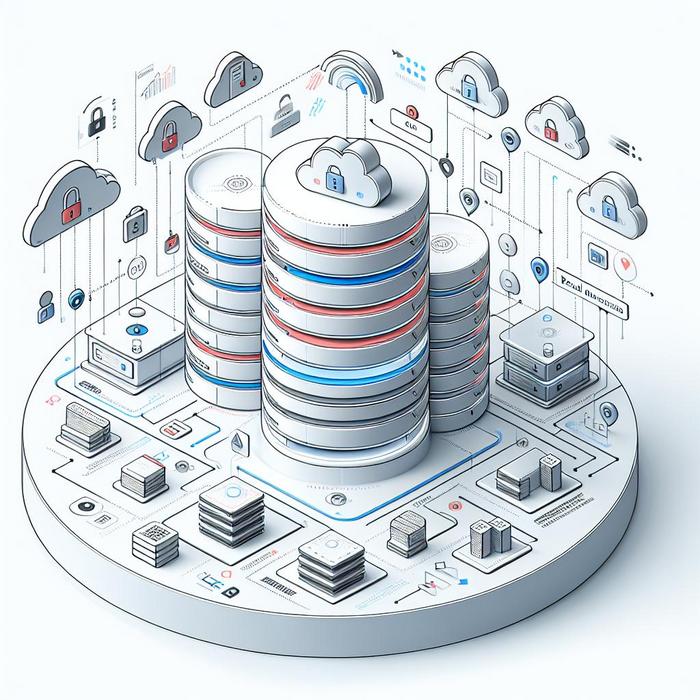Table of Contents Hide
Data Catalog Key Features That Every IT Expert Should Know
 8 MIN. READING
8 MIN. READING
Data Discovery And Access
How can organizations ensure their data is readily available and easily accessible to authorized users while maintaining strict security protocols? Modern businesses operate on data, and effective data utilization hinges on seamless data discovery and access. This is where a robust data catalog becomes indispensable. A well-implemented data catalog serves as a central repository of metadata, providing a comprehensive view of available data assets. This single source of truth empowers users to quickly locate and understand relevant data, accelerating data-driven initiatives. For example, consider a scenario where a business analyst needs to identify datasets for a customer churn analysis. A data catalog with advanced search and filtering capabilities allows them to pinpoint the necessary data without tedious manual searching. This streamlines the analytical process, enabling faster insights and informed decision-making.
Metadata Management And Data Lineage
What measures can ensure data quality and trustworthiness for critical business decisions? High-quality metadata is the bedrock of any successful data strategy. A data catalog provides a platform for comprehensive metadata management, including capturing technical metadata (data types, schema) and business metadata (data definitions, ownership). Furthermore, understanding data lineage—the journey of data from origin to consumption—is crucial for ensuring data reliability. A data catalog captures and visualizes data lineage, allowing users to trace data transformations and identify potential sources of errors or inconsistencies. This capability is vital for regulatory compliance and maintaining data integrity. This clear understanding of data provenance instills confidence in data-driven decisions.
Data Governance And Compliance
How can organizations ensure they meet stringent data governance and compliance requirements? Data regulations such as GDPR and CCPA mandate strict control over sensitive data. A data catalog helps organizations achieve compliance by providing a centralized platform to manage data access policies, enforce data anonymization measures, and track data usage. By centralizing these controls, organizations can minimize the risk of data breaches and ensure compliance with regulatory requirements. You can learn more about automating compliance with software tools here. Data security testing tools offer a suite of capabilities to protect your sensitive data from vulnerabilities and threats. Explore the best security testing tools for 2024 in this article.
Self-Service Data Provisioning And Database Virtualizitiong
How can organizations accelerate data access for development, testing, and analytical needs? Database virtualization creates a streamlined data provisioning process for non-production environments. This technology allows users to quickly spin up virtual copies of production databases without physically copying the data. This reduces storage costs and accelerates data delivery for development and testing teams. In the realm of analytics, database virtualization allows analysts to work with realistic data subsets without impacting production systems. This fosters faster experimentation and accelerates the delivery of data-driven insights.
Collaboration And Data Sharing
How can organizations foster collaboration and efficient data sharing across teams and departments? A data catalog facilitates collaboration by providing a shared platform for data discovery, documentation, and discussion. Users can annotate datasets, share insights, and collaborate on data-related projects. This collaborative environment breaks down data silos and promotes a data-driven culture across the organization. Cloud solutions offer a transformative approach to this process. To delve deeper into the world of cloud solutions for this specific area, take a look at this informative piece.
Cost Optimization And Resource Efficiency
How can organizations optimize data management costs and improve resource utilization? A data catalog can contribute to cost optimization by streamlining data discovery and access. By improving data visibility, organizations can reduce redundant data storage and optimize resource allocation. Efficient data provisioning through database virtualization minimizes the need for physical data copies, leading to further cost savings in storage and infrastructure. Furthermore, automating data governance processes within the data catalog reduces manual effort and improves operational efficiency.
Choosing The Right Data Catalog Solution
When evaluating data catalog solutions, organizations should consider factors like:
* Scalability and Performance: The chosen solution must handle the organization’s data volume and user base without performance degradation.
* Integration Capabilities: Seamless integration with existing data infrastructure is essential for effective data management.
* Security Features: Robust security measures are crucial for protecting sensitive data and maintaining compliance.
* User Experience: An intuitive and user-friendly interface promotes adoption and maximizes user productivity.
By carefully considering these factors, organizations can select a data catalog solution that aligns with their specific needs and supports their data-driven initiatives.
Data Quality And Consistency
How can businesses ensure the reliability and accuracy of their data for informed decision-making? Maintaining high data quality is paramount for accurate reporting, effective analytics, and reliable business intelligence. A robust framework for creating and managing realistic datasets for non-production environments plays a vital role here. By implementing rigorous data anonymization techniques and ensuring data consistency across different environments, organizations can minimize the risk of errors and inconsistencies that can undermine data integrity. This ensures that decision-makers have access to trustworthy information, fostering confidence in their strategic choices. Maintaining data consistency becomes even more critical when dealing with distributed data systems and diverse data sources.
Data Anonymization Techniques For Enhanced Security
What strategies can organizations employ to safeguard sensitive data while maintaining its utility for development and testing? Data anonymization techniques are essential for protecting sensitive information while preserving the value of data for non-production purposes. Methods like pseudonymization, tokenization, and data perturbation allow organizations to create realistic datasets that retain the statistical properties of the original data without exposing sensitive details. This ensures that development and testing teams can work with representative data without compromising data privacy and security. Choosing the right anonymization technique depends on the specific data type, sensitivity level, and intended use case. Explore various data anonymization techniques here.
Streamlined Workflows For Agile Development
How can organizations accelerate software development lifecycles by optimizing data provisioning processes? Efficient data provisioning is crucial for supporting agile development methodologies. Rapid access to realistic data enables developers to test new features and functionalities effectively, accelerating the development process and shortening release cycles. By leveraging database virtualization and automated provisioning workflows, organizations can eliminate bottlenecks associated with traditional data copying and provisioning methods, empowering development teams to work with greater agility and speed. This ultimately leads to faster time-to-market for new products and services. For a deeper dive into optimizing realistic data for mobile application development, check out this resource.
Enhanced Business Intelligence And Reporting
How can organizations leverage high-quality, readily-available data to improve business intelligence and reporting accuracy? Accurate and up-to-date data is the cornerstone of effective business intelligence and reporting. By ensuring the quality and consistency of data used for reporting purposes, organizations can gain deeper insights into business performance, identify trends, and make informed decisions based on reliable information. This leads to better strategic planning, improved operational efficiency, and a competitive advantage in the market. Furthermore, readily-available data empowers business analysts to conduct ad-hoc analysis and explore data from different angles, fostering data-driven decision-making at all levels of the organization.
Reduced Storage Costs And Infrastructure Overhead
What strategies can organizations adopt to minimize the costs associated with storing and managing large volumes of data for non-production purposes? Traditional approaches to data provisioning often involve creating multiple copies of production data for different environments, leading to significant storage costs and infrastructure overhead. By adopting database virtualization and other advanced data techniques, organizations can reduce their storage footprint and minimize the need for expensive hardware. This not only lowers capital expenditure but also reduces operational costs associated with managing and maintaining physical storage infrastructure. These cost savings can be reinvested in other strategic initiatives, contributing to overall business growth. Explore essential features of data catalogs further here.
Compliance With Data Privacy Regulations
How can organizations ensure adherence to evolving data privacy regulations while leveraging data for development and testing? Meeting stringent data privacy regulations like GDPR and CCPA requires careful management of sensitive data in non-production environments. By implementing data anonymization techniques and robust access control mechanisms, organizations can protect sensitive information and comply with regulatory requirements. This not only mitigates the risk of data breaches and associated penalties but also fosters trust with customers and stakeholders. Staying updated with the latest data privacy regulations and adopting best practices for data management is crucial for maintaining compliance and safeguarding sensitive data. Learn more about mastering data privacy regulations in 2024 here. Understanding the must-have features of data catalogs can greatly assist in meeting these requirements. Explore these features in detail here. You can also find valuable insights on selecting the right data catalog tool with key features outlined here.


